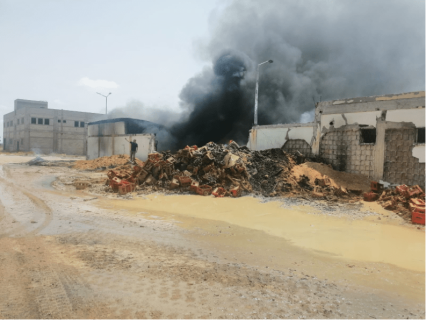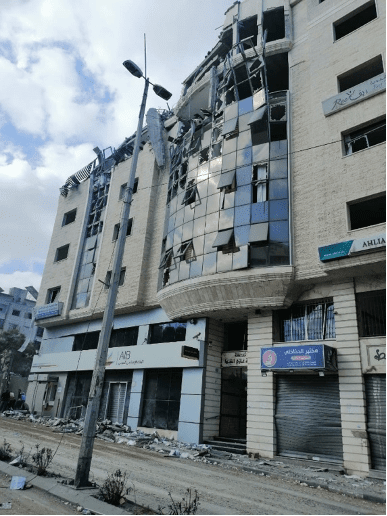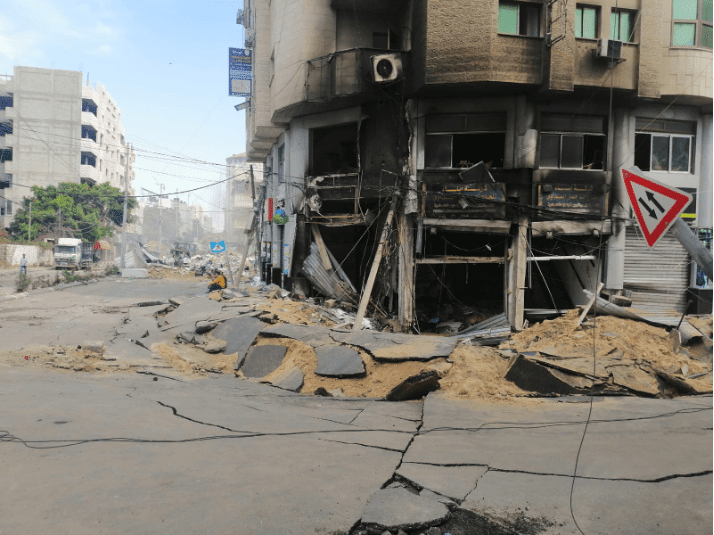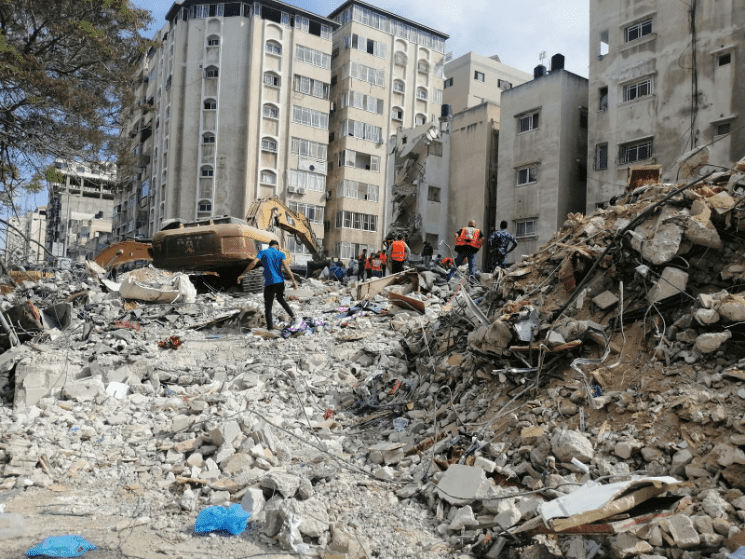
Since 10 May 2021, Israel’s military offensive on the Gaza Strip has cost a devastating human toll. As of 20 May 2021, 6:00 pm, the Palestinian Ministry of Health in Gaza reported 232 Palestinian casualties, including 65 children, and 1,900 injuries.[1]Al-Haq’s field reports have documented the indiscriminate and systematic attacks of the Israeli Occupying Forces (IOF) in the carrying of ariel bombings over the Gaza Strip, targeting high rise tower blocks, residential buildings, commercial properties, administrative institutions, cultural and religious centers, banks and agricultural lands.
Economy has long been the sinews of war. Whether by directly targeting business sites, or by causing collateral damage to commercial properties, the Israeli Occupying Forces (IOF) seizes the opportunity to deeply and sustainably affect the Palestinian economy already on the fringe of collapse. More than 80 percent of Palestinians depend on international aid, without alleviating a continuing cycle of poverty – with a poverty rate above 50 percent in 2017, food insecurity, lack of drinkable water and inadequate healthcare.[2] Meanwhile, the Gaza real per capita gross domestic product (GDP) dropped by 29 per cent in 2019 compared to 2006 – “The precipitous deterioration prompted the United Nations to warn that Gaza might become unliveable by 2020”.[3]

Ghazi Shawa building, Al-Rimal neighborhood, Gaza City © Al-Haq May 2021
Direct Targeting of Civilian Banks and Financial Institutions as Military Objectives
A certain number of financial businesses, including different branches of the Islamic National Bank and the Palestinian Production Bank, have constituted direct military targets by the Israeli Occupying Forces:
- On 13 May 2021, at around 6:10 am, the headquarters of the Islamic National Bank, located at the basement level of Haydar Al-Agha Tower, near the Abu Hamid roundabout, Khan Yunis, was targeted, bombed and completely destroyed by two IOF missiles.
- On 13 May 2021, at around 7:55 am, an Israeli drone fired three missiles at the Islamic National Bank, in the Doha Building, Omar bin Al-Khattab Street, Rafah. Ten minutes later, an Israeli warplane launched another missile, leading to severe to moderate material damage a number of offices.
- On 13 May 2021, at 7:00 pm, the Israeli warplanes bombed the headquarters of the Production Bank on the ground floor of a two-story building, the ground floor of the bank’s headquarters, and a residential house of citizen Ismail Mustafa al-Saqa, located near Al-Aqsa Community College, Khan Yunis. As a result, the headquarters was completely destroyed and the residential floor was severely damaged.
- On 15 May 2021, Israeli warplanes completely destroyed, at 10:20 pm, the headquarters of the Islamic National Bank located at the bottom of the Kazem Abu Shaaban building in Al-Rimal neighborhood in the center of Gaza City.
- On 15 May 2021, the Israeli Occupying Forces targeted and completely destroyed the Nour al-Din building, located on Al-Shifaa Street, Gaza City, owned by Hussam Fuad Nour al-Din, whose ground floor hosted the Palestinian Production Bank.
Indiscriminate and Intended Collateral Damages on Business Properties
On several occasions, Al-Haq documented commercial facilities that have suffered collateral damage of bombardments targeting surrounding civilian residential buildings, including shops, factories and private companies:
- On 11 May 2021, the Galilee Ice Cream Factory owned by Khalil Habib was completely destroyed, at Street 10 near Kuwait Junction, southeast of Gaza City, in addition to the partial damage of neighboring factories.
- On 11 May 2021, a factory belonging to one of the Palestinian resistance factions, in the Abu Al-Khair Industrial Zone, near Al-Qurum roundabout, Jabalia, northern Gaza Strip, was targeted.
- On 11 May 2021, at approximately 7:45 pm, Israeli warplanes destroyed the 13-floor Hanadi Tower, next to the fishermen port, west of Gaza City, home to a number of offices of private companies.
- On 12 May 2021, at around 12:30 pm, Israeli warplanes targeted Majed Hamed Bakir Al-Yazji’s building, Al-Nafaq Street, Al-Manara neighborhood, near Al-Tawalbeh Mosque, east of Gaza City. A special factory for electrical appliances was located below the third-floor building.
- On 13 May 2021, at about 1:10 am, around 20 missiles were launched on eight houses located on Beit Lahia Street, center of Beit Lahia, North Gaza. The attack killed two civilians, Abd al-Rahim Muhammad Abdullah al-Madhoun, 62 and Halima Ali Muhammad al-Madhoun, 65, and injured 33 civilians, in addition to destroying many properties, including commercial companies, the office of Faten Lending Corporation, a law firm, an educational center, and shops.
- On 14 May 2021, around 2:30 am, Israeli warplanes destroyed the Mahmoud Abu Halima Sons Company for Iron Formation and Trade, located opposite to Al Shawa Petroleum Station, at the intersection of Mansoura Street with Salah Al-Din Street in Al-Shejaiya neighborhood, East of Gaza City, notably causing excessive and disproportionate damage to a number of shops and industrial workshops located in the vicinity of the targeted company. Muhammad Mahmoud Abu Halima, the company owner, estimated his economic loss to three million US dollars.
- On 15 May 2021, at approximately 11:25 am, Israeli warplanes bombed the Al-Hasoumi shops for the sale of building materials in Al-Atatrah neighborhood, northwest of Beit Lahia, North Gaza, with two missiles.
- On 15 May 2021, Israeli warplanes bombed the 12-storey Al-Galaa Tower, located on Al-Jalaa Street next to the Watan Tower in the center of Gaza City, notably containing six floors of commercial offices. Al-Galaa tower was completely demolished and neighboring commercial buildings were severely damaged.
- On 15 May 2021, at around 5:15 pm, Israeli warplanes bombed the Shehadeh family’s building, in Jabalia camp in the northern Gaza governorate, leading to the complete destruction of the Al-Kurdi stores for materials company, located on the ground floor.
- Some minutes later, the Israeli artillery shelled dozens of bombs in the northwestern areas of the town of Beit Lahia in the northern Gaza Strip, causing a huge fire in the adjacent Khudair Brothers and Medawar Medicines Companies.
- On 17 May 2021, nine factories and warehouses, located in the industrial zone east of the Shejaiya neighborhood, east of Gaza City, were bombed by the Israeli Occupying forces, while they were already experiencing economic hurdles due to the Corona outbreak, and the long years of siege on the Gaza Strip. Among the demolished factories: Al-Harir Factory for the manufacture of chips, Siksek factory for plastic pipes, Al-Wadia factory for food industries, Maatouq ice cream factory, Clever detergents factory, Abu Iskandar nylon factory, Company PWS Renewable Energy, Bedkou and the Rafiq Textiles & Readymade Garments Company.
- On 17 May 2021, at approximately 5:10 pm, the six-floor Mashareq building of the Ministry of Endowments and Religious Affairs, near Ansar South Junction, west of Gaza City, housing the Mashareq Media Company, the headquarters of the General Administration of Women's Work, the headquarters of the Ministry of Endowments and Religious Affairs, the headquarters of the Orphans Care Fund, the Al-Nahda Library and Talal Abu-Ghazaleh's audit office. The initial bombardment severely damaged the architecture. The building was the target of a second bombing at approximately 1:35 at dawn on 18 May 2021 that resulted in its complete destruction.
- On 18 May 2021, around 1:30 pm, the IOF targeted a store of paint materials owned by the Hanif family, Khirbet al-Adas, northeast of Rafah.
Large-Scale Destruction of Al-Rimal Neighborhood, will have Long Term Impact on the Socio-Economic Viability of Gaza City
Significantly, from 11 May 2021, the Israeli Occupying Forces initiated a series of systematic and violent bombing blasts on Al-Rimal neighborhood, one of the most vibrant neighborhoods of Gaza City, and an essential commercial artery. The successive bombings caused the death of 43 civilians, including 18 children, as of 17 May 2021.

Al-Rimal neighborhood, Gaza City © Al-Haq May 2021

Al-Rimal neighborhood, Gaza City © Al-Haq May 2021
- At 9:30 pm, on 11 May 2021, Israeli drones severely damaged the 10-floor Al-Jawhara Tower, located at Dabit Junction, which housed offices of private companies and shops, amongst other.
- At approximately 6:30 pm, on 12 May 2021, Israeli warplanes bombed and destroyed the 14-story Al-Shorouk Tower. The tower contained dozens of offices, clinics, private companies, and a number of press and media institutions. The bombing also caused severe damage to a large number of commercial buildings, Khayal Mall and the Capital Mall, and dozens of neighboring shops, most of which were completely destroyed.
- Around 8:45 am the morning after, Israeli warplanes came back to fully destroy the 7-floor Al-Walid Building, located in Khalid Bin Al-Walid Street. It contained 17 units, including a number of offices, companies, shops, and apartments, over 280 square meters.
- On 16 May 2021, at dawn, Israeli warplanes bombed, in several successive raids, about 50 strikes, Abu Al-Auf family’s building, as well as Al-Wehda Street, damaging a significant number of roads connected to Al-Wehda Street. The strikes affected several neighboring offices and malls.
- On 17 May 2021, at 6:45 pm, the IOF attacked, without prior warning, the top three floors of the Ghazi Shawa building, in the middle of Al-Wehda. The Shawa building notably housed offices for commercial companies, the headquarters of the Islamic National Bank, the Needle and Thread shop, Al-Dakhakhny Lab, the Reef Finance Corporation, the National Finance Company, Basma Clinic and a number of offices for commercial companies and clinics. The bombing also damaged the Al-Amal Building and the Al-Amal Institute for Orphans, in addition to deteriorating a number of neighboring shops and commercial establishments.
The demolition of Al-Shorouk tower, and the crippling of its adjacent, most vital, Omar Al-Mukhtar Street, will severely impact the long term dynamism of Al-Rimal neighborhood, which is one of the most famous neighbourhoods in Gaza City.
Israel’s Targeting of Business Properties in Violations of Basic Principles of Humanitarian Law
Business properties are considered, under Article 52 of the 1977 Additional Protocol, I as civilian objects, namely “all objects which are not military objectives.”[4] They are protected by the principle of immunity of civilian objects.[5] According to Article 52(2) of the 1977 Additional Protocol I, reflective of customary international law provides for the principle of distinction between civilian objects and military objectives,[6] requiring that “attacks shall be limited strictly to military objectives.”
Yet, since the launch of Israel’s offensive on Gaza, Al-Haq has reported a consistent pattern of the destruction of business properties as military targets. Civilian business facilities have been treated as direct military targets, or have undergone significant collateral damage as a result of bombardments affecting surrounding structures and infrastructure.
As per Article 52(2) of the 1977 Additional Protocol I, supported by customary law, “military objectives are limited to those objects which by their nature, location, purpose or use make an effective contribution to military action and whose total or partial destruction […] offers a definite military advantage.” [7]
To qualify as a military object, an object must comply with two requirements:[8]
- Its nature, location or use makes an effective contribution to military action;
An object makes military contribution ‘by nature’ if it can be directly used by the armed forces, namely ‘weapons, equipment, transports, fortifications, depots, buildings occupied by armed forces, staff headquarters, communication centers.’
An object contributes to military efforts ‘by location’ because it could potentially ‘be seized or because it is important to prevent the enemy from seizing it’
An object is used for military ‘purpose’ if they are used by the armed forces. However, Article 52(3) of the 1977 Additional Protocol I holds that “in case of doubt” that a civilian object “is being used to make an effective contribution to military action, it shall be presumed not to be so used.” [9]
- Its total or partial destruction in the circumstances ruling at the time offers a definite military advantage.
Nonetheless, the destruction of a civilian object should still offer a ‘definite,’ military advantage in contrast to ‘potential or indeterminate advantages,’ based on relevant information.[10] The definite military advantage must be concrete, direct and assessed for every single military objective.[11]
Most of the targeted business properties do not correspond to any of these categories. They do not offer any effective contribution to military action per se. Their location in civilian centers do not render their destruction important in the conduct of hostilities.
Even where commercial premises are for arguments sake, located in buildings occupied by resistance forces, or may make a substantial contribution to the resistance, as in the case of financial institutions, the principle of precaution would still prevail. The Israeli Occupying Forces still need to demonstrate and provide sound evidence that their strategic targets respond to one of those categories that would offer a definite military advantage.
On the contrary, field reports and documentation highlight without any doubt the carrying out of indiscriminate attacks on civilian buildings that notably host businesses. Under Article 51(4)(a) of Additional Protocol I, supported by customary law, indiscriminate attacks “which are not directed at a specific military objective […] and consequently […] are of a nature to strike military objectives and […] civilian objects without distinction” are prohibited.[12] In addition, respect for the principle of precaution in attack, enshrined in customary law, according to which “all feasible precautions must be taken to avoid, and any event to minimize, incidental […] damage to civilian objects”[13] would still prevail. Under Article 58 of the 1977 Additional Protocol I, the military forces must endeavor to make any effort to “avoid locating military objectives within or near densely populated areas,” and to ‘protect […] civilian objects under their control against the dangers resulting from military operations.”[14] As made clear by Al-Haq documentation, and especially in the case of Al-Rimal neighborhood, the Israeli Occupying Forces have perpetrated indiscriminate attacks on civilian buildings, without due respect to the prohibition of indiscriminate attacks and the principle of precaution. Many business properties have been severely impacted, and even decapacitated, with a long term economic cost, further crippling the Palestinian economy in the Gaza Strip, in a manifest act of collective punishment.


Karni Industrial Zone, Gaza City © Al-Haq May 2021
Conclusion
The targeting of business properties in the course of the IOF offensive on the Gaza Strip cannot be justifying under the well-enshrined principles of international humanitarian law. Rather, they form part of a broader strategy to permanently affect the viability of the Gaza economy, as well as the ability of the Palestinian people residing in Gaza to develop their economic capacities. It is in line with the overall colonial project that has been driving Israel’s policies and practices since its inception: that by weakening Palestine’s social, political, cultural and economic life, Israel intends to entrench its domination and fragmentation of the Palestinian people and their lands, continuing its inhumane acts of apartheid.
Al-Haq recalls that “intentionally directing attacks against civilian objects, that is, objects which are not military objectives” constitutes a war under Article 8(2)(b)(ii) of the Rome Statute of the International Criminal Court. Al-Haq urges the Prosecutor of the International Criminal Court (ICC) to prioritize the investigation into Israel’s military attacks on civilian infrastructure in the Gaza Strip, under Article 8(2)(b)(ii) of the Rome Statute.
[1] Gaza Ministry of Health, 19 May 2021, https://www.moh.gov.ps/portal/two-hundred-and-twenty-seven-227-palestinians-have-so-far-been-killed/
[2] United Nations Conference on Trade and Development, Report on UNCTAD Assistance to the Palestinian People: Developments in the Economy of the Occupied Palestinian Territory, TD/B/67/5, 5 August 2020, paras.23-21, https://www.un.org/unispal/wp-content/uploads/2020/09/TD.B.67.5.pdf
[3] United Nations Conference on Trade and Development, Report on UNCTAD Assistance to the Palestinian People: Developments in the Economy of the Occupied Palestinian Territory, TD/B/67/5, 5 August 2020, para.51, https://www.un.org/unispal/wp-content/uploads/2020/09/TD.B.67.5.pdf
[4] 1977 Additional Protocol I, Article 52(1), https://ihl-databases.icrc.org/applic/ihl/ihl.nsf/Article.xsp?action=openDocument&documentId=F08A9BC78AE360B3C12563CD0051DCD4 ; Rule 9, Customary International Humanitarian Law, https://www.icrc.org/en/doc/assets/files/other/customary-international-humanitarian-law-i-icrc-eng.pdf
[5] 1977 Additional Protocol I, Commentary 1987 in Article 52, para.2011, https://ihl-databases.icrc.org/applic/ihl/ihl.nsf/Comment.xsp?action=openDocument&documentId=5F27276CE1BBB79DC12563CD00434969
[6] 1977 Additional Protocol I, Article 52(2), https://ihl-databases.icrc.org/applic/ihl/ihl.nsf/Article.xsp?action=openDocument&documentId=F08A9BC78AE360B3C12563CD0051DCD4 ; Rule 7, Customary International Humanitarian Law, https://ihl-databases.icrc.org/customary-ihl/eng/docs/v1_rul_rule7
[7] 1977 Additional Protocol I, Article 52(2), https://ihl-databases.icrc.org/applic/ihl/ihl.nsf/Article.xsp?action=openDocument&documentId=F08A9BC78AE360B3C12563CD0051DCD4
[8] 1977 Additional Protocol I, Commentary 1987 in Article 52, para.2018, https://ihl-databases.icrc.org/applic/ihl/ihl.nsf/Comment.xsp?action=openDocument&documentId=5F27276CE1BBB79DC12563CD00434969
[9] 1977 Additional Protocol I, Article 52(3), https://ihl-databases.icrc.org/applic/ihl/ihl.nsf/Article.xsp?action=openDocument&documentId=F08A9BC78AE360B3C12563CD0051DCD4
[10] 1977 Additional Protocol I, Commentary 1987 in Article 52, para.2027, https://ihl-databases.icrc.org/applic/ihl/ihl.nsf/Comment.xsp?action=openDocument&documentId=5F27276CE1BBB79DC12563CD00434969
[11] 1977 Additional Protocol I, Commentary 1987 in Article 52, para.2028, https://ihl-databases.icrc.org/applic/ihl/ihl.nsf/Comment.xsp?action=openDocument&documentId=5F27276CE1BBB79DC12563CD00434969 ; Rule 18, Customary International Humanitarian Law, https://ihl-databases.icrc.org/customary-ihl/eng/docs/v1_rul_rule18
[12] Rule 12, Customary International Humanitarian Law, https://ihl-databases.icrc.org/customary-ihl/eng/docs/v1_rul_rule12#:~:text=Indiscriminate%20attacks%20are%20those%3A(a,limited%20as%20required%20by%20international ; 1977 Additional Protocol I, Article 58(b)-(c), 1977 Additional Protocol I, Article 51, https://ihl-databases.icrc.org/applic/ihl/ihl.nsf/Article.xsp?action=openDocument&documentId=4BEBD9920AE0AEAEC12563CD0051DC9E
[13] Rule 15, Customary International Humanitarian Law, https://ihl-databases.icrc.org/customary-ihl/eng/docs/v1_rul_rule15
[14] 1977 Additional Protocol I, Article 58(b)-(c), https://ihl-databases.icrc.org/applic/ihl/ihl.nsf/Article.xsp?action=openDocument&documentId=C995BF5C5BCFB0E2C12563CD0051DDB2 ; Rule 22, Customary International Humanitarian Law, https://ihl-databases.icrc.org/customary-ihl/eng/docs/v1_rul_rule22

